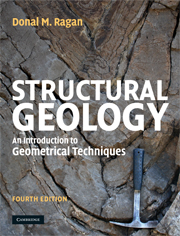Book contents
- Frontmatter
- Contents
- Preface
- Acknowledgements
- 1 Structural planes
- 2 Thickness and depth
- 3 Lines and intersecting planes
- 4 Planes and topography
- 5 Stereographic projection
- 6 Rotations
- 7 Vectors
- 8 Faults
- 9 Stress
- 10 Faulting
- 11 Deformation
- 12 Strain
- 13 Flow
- 14 Folds
- 15 Parallel folds
- 16 Similar folds
- 17 Folds and topography
- 18 Structural analysis
- 19 Tectonites
- 20 Drill hole data
- 21 Maps and cross sections
- 22 Block diagrams
- Appendices
- References
- Index
5 - Stereographic projection
Published online by Cambridge University Press: 05 June 2012
- Frontmatter
- Contents
- Preface
- Acknowledgements
- 1 Structural planes
- 2 Thickness and depth
- 3 Lines and intersecting planes
- 4 Planes and topography
- 5 Stereographic projection
- 6 Rotations
- 7 Vectors
- 8 Faults
- 9 Stress
- 10 Faulting
- 11 Deformation
- 12 Strain
- 13 Flow
- 14 Folds
- 15 Parallel folds
- 16 Similar folds
- 17 Folds and topography
- 18 Structural analysis
- 19 Tectonites
- 20 Drill hole data
- 21 Maps and cross sections
- 22 Block diagrams
- Appendices
- References
- Index
Summary
Introduction
For any problem involving distances an orthographic construction is always required. For purely angular relationships, however, there is an alternative approach which is both quick and efficient. It also provides a means of solving more advanced problems which would otherwise be quite difficult.
Given an inclined plane containing a line (Fig. 5.1a), imagine a sphere of unit radius centered at a point O on the outcrop trace of an inclined structural plane containing a structural line (Fig. 5.1b). This plane passes through the center and therefore contains a diameter of the sphere and every such diametral plane intersects the sphere as a great circle. The line in this plane intersects the sphere as a point on this circle. This is called the spherical projection of the plane and line. We now require a way of reducing this three-dimensional representation to two dimensions. The choice is dictated by the desire to preserve angles and this is best accomplished with the method of stereographic projection. It is treated in most introductory structural geology texts. The books by Phillips (1971) and Lisle and Leyshon (2004) are particularly useful.
Stereogram
The geometrical basis of this method involves the projection of a point on the sphere to the horizontal diametral plane. Consider the structural line whose attitude is 30/090. On the east-trending vertical diametral plane of the sphere the line is represented by the radius OP with plunge p = 30° (Fig. 5.2a).
- Type
- Chapter
- Information
- Structural GeologyAn Introduction to Geometrical Techniques, pp. 88 - 108Publisher: Cambridge University PressPrint publication year: 2009



